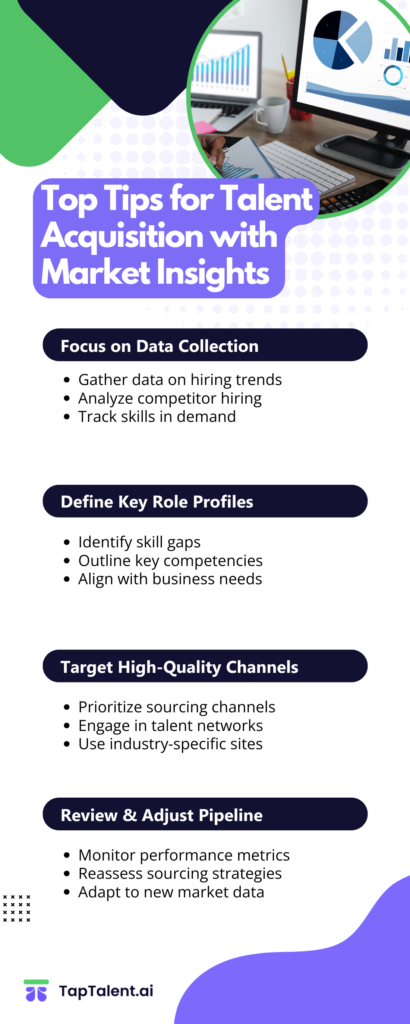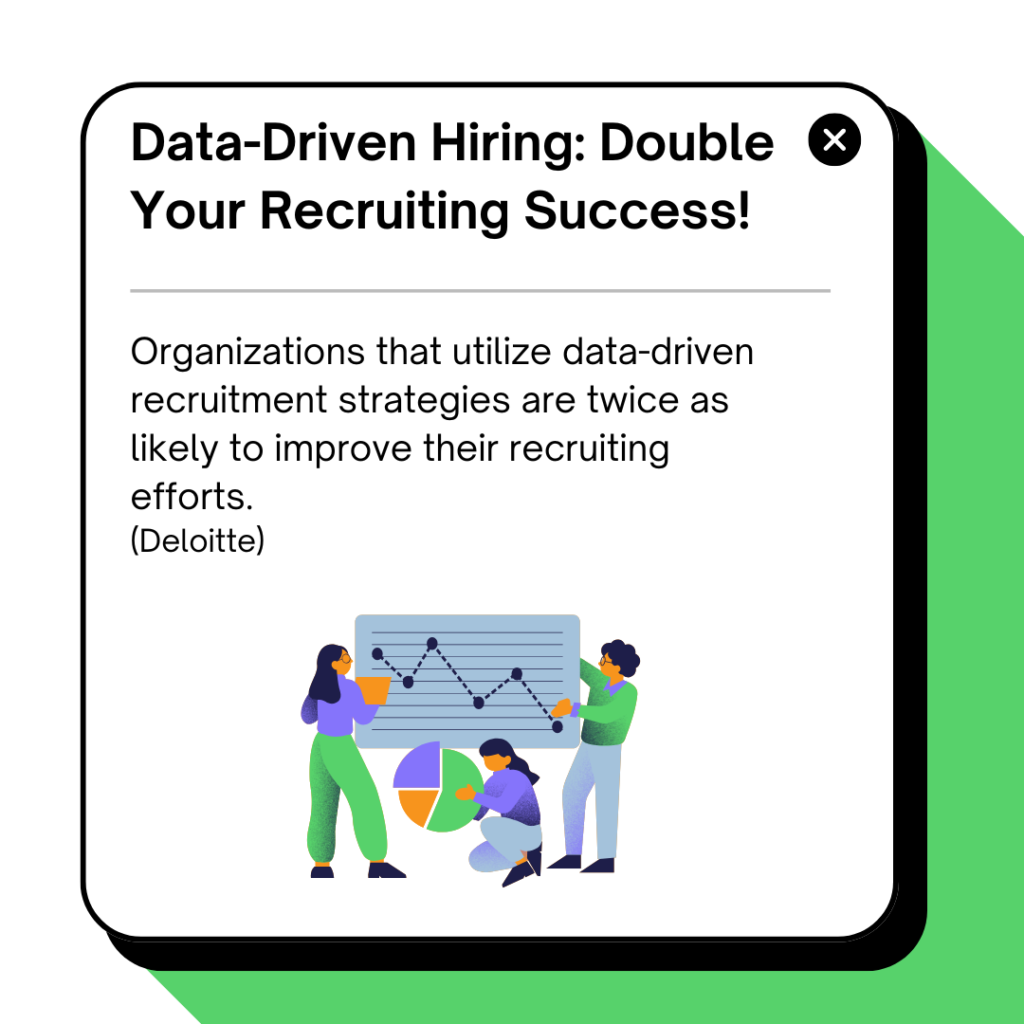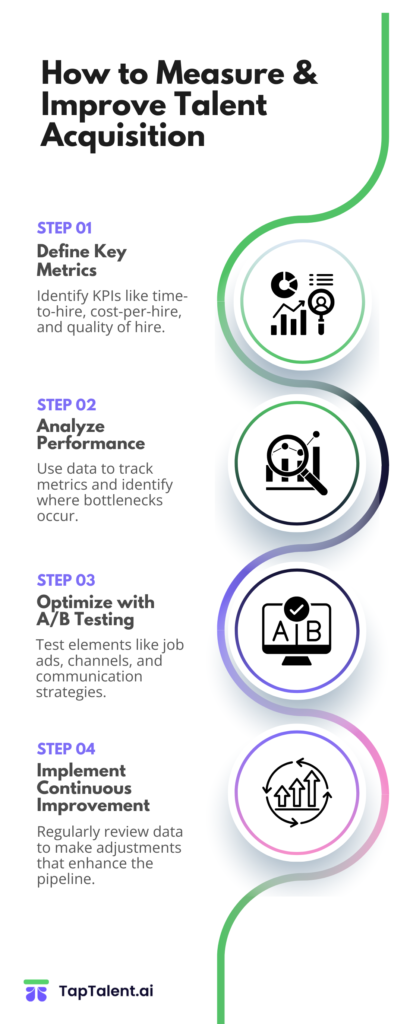Introduction
In today’s rapidly evolving job market, effective talent acquisition can be the difference between a thriving organization and one that struggles to keep up. Recent studies reveal that companies leveraging market insights in their recruitment strategies are 50% more likely to attract top-tier talent compared to those that don’t. This blog post delves into the transformative power of market insights in building an effective talent acquisition pipeline, addressing common recruitment challenges that many companies face in today’s competitive landscape.
We’ll explore how understanding the talent landscape by defining Ideal Candidate Profiles and conducting competitive analysis can give your organization a strategic edge. Discover how leveraging data from various sources like job boards and social media can enhance proactive sourcing efforts. We’ll also discuss optimizing the candidate experience through employer branding and relationship management, backed by the latest market trends and technology.
As you read on, we’ll guide you through measuring pipeline effectiveness using key performance indicators and data-driven optimization. By the end of this post, you’ll have a comprehensive roadmap to create a future-ready talent pipeline, ensuring your organization remains a leader in attracting and retaining talent.

Understanding the Talent Landscape
To navigate today’s competitive market effectively, understanding the talent landscape is crucial. This involves defining your Ideal Candidate Profile (ICP), conducting competitive analysis, recognizing market trends, and exploring the prevailing technology landscape. Each component provides crucial insights that can significantly enhance the effectiveness of a talent acquisition pipeline.
Defining the Ideal Candidate Profile (ICP)
An essential step in understanding your target audience is clearly defining an Ideal Candidate Profile. Doing so aligns recruitment efforts with organizational needs, reducing time and effort spent on unsuitable candidates. According to industry experts, companies that meticulously define their ICPs typically experience up to a 20% improvement in recruitment efficiency.
-
Demographics: Consider age, education, experience, and location to tailor marketing and engagement strategies.
-
Skills and Competencies: Identify core and unique skills necessary for success in particular roles.
-
Cultural Fit: Evaluate personality traits and values to ensure alignment with company culture.
Competitive Analysis
Understanding your competitors’ strategies can offer a strategic advantage. By evaluating their talent acquisition tactics, you can identify opportunities to differentiate your approach. Competitor analysis might reveal that others are focusing heavily on specific channels like LinkedIn or job fairs, signaling potential gap areas for you to explore more lucrative avenues such as niche job boards or targeted social media tactics.
-
Strengths and Weaknesses: Compare your employer branding against competitors.
-
Market Position: Assess competitors’ compensation packages and benefits.
Market Trends
Staying informed about current market trends can significantly influence the success of your recruitment strategy. For instance, insights into evolving salary benchmarks, required skills, and ways candidates prefer to communicate are vital. In a study, companies adhering to up-to-date market trends witnessed a 30% enhancement in candidate engagement metrics.
-
Salary Trends: Regularly update salary bands to remain competitive.
-
Skills Demand: Be aware of emerging skill sets in the industry.
-
Communication Preferences: Adapt recruitment communication to align with candidate preferences.
Technology Landscape
Finally, the technology landscape continues to shape talent acquisition methods. Knowing the tools available for recruitment enables organizations to streamline and optimize their hiring processes. Technologies like AI-driven recruiting systems or advanced data analytics can provide actionable insights, predict hiring outcomes, and automate routine tasks, ultimately increasing efficiency by 25%.
-
Recruitment Management Software: Integrate comprehensive tools for seamless applicant tracking.
-
Data Analytics: Leverage big data to gain insights into candidate behavior and preferences.
-
Artificial Intelligence: Use AI tools to identify passive candidates and speed up the recruitment process.
In summary, understanding the talent landscape by defining your ICP, conducting competitive analysis, staying ahead of market trends, and leveraging contemporary technology can significantly bolster your talent acquisition pipeline. With a solid grasp of these components, you can develop strategies that edge out competitors and attract top-tier talent efficiently. Next, we will explore how to leverage data sources for proactive sourcing, enhancing your recruitment strategy to meet future organizational needs.
Leveraging Data for Proactive Sourcing
Once you have a solid understanding of the talent landscape, the next logical step is to harness this knowledge in identifying and engaging potential candidates more effectively. Proactive sourcing through data is akin to setting a radar for talent detection — thoughtfully curated, accurate, and timely data shines a spotlight on the hidden gems in the workforce. By leveraging data strategically, organizations can transcend traditional approaches to recruitment and gain access to a broader spectrum of candidates, including those not actively searching for new opportunities.
Data Sources: Powerhouses of Potential
The foundation of effective proactive sourcing lies in identifying and utilizing robust data sources. Today’s digital age provides numerous channels:
-
Job Boards and Databases: Platforms like Indeed and Glassdoor not only host active job seekers but also provide data on job market trends and salary benchmarks.
-
Social Media Platforms: LinkedIn, Facebook, and even Instagram are treasure troves for sourcing passive candidates. They offer rich insights into candidates’ professional experiences, skills, and interests.
-
Talent Networks: Engaging with industry-specific forums and communities can uncover talent that aligns with your unique needs.
-
Internal Databases: Maintaining an organized and continually updated candidate database can significantly streamline future hiring processes.
With these sources, recruitment teams can remain vigilant and responsive to evolving market demands while expanding their candidate pool.
Data Analysis Techniques: Turning Information into Insight
Data alone isn’t enough; it’s the analysis that transforms it into actionable insights. Utilizing advanced search techniques and mapping solutions allows organizations to sift through vast datasets with precision.
-
Boolean Searches: By employing advanced search operators, recruiters can refine their searches to pinpoint candidates with exact skill sets.
-
Heat Mapping: Visual tools that identify geographical concentrations of desired skills can guide outreach efforts more effectively.
These analytical techniques empower recruiters to delve deeper into data, ensuring that their sourcing strategies are not just broad, but targeted and efficient.
Engaging Passive Candidates: More Than Meets the Eye
A delicate art in proactive sourcing is the engagement of passive candidates — individuals who are not actively seeking new positions but may be open to the right opportunity. Approaching passive candidates requires tact and personalization.
-
Tailored Messaging: Craft personalized messages that resonate with the candidate’s background, achievements, and career aspirations.
-
Relationship Building: Regularly interact with potential candidates through informational interviews and networking events, developing rapport over time.
-
Employee Value Proposition (EVP): Highlight unique aspects of your organizational culture and opportunities for professional growth to entice passive candidates.
Passive candidate engagement is like nurturing a plant; it requires patience and the right conditions to bloom.
Building and Maintaining a Candidate Database
Creating a dynamic and comprehensive candidate database is akin to cultivating a garden where future workforce potentials flourish. A well-maintained database serves as a ready reservoir of talent when openings arise, minimizing the time between identifying and hiring candidates.
-
Regular Updates: Ensure accuracy by consistently updating candidate information with recent resumes, new certifications, or updated contact details.
-
Segmented Lists: Organize the database categorically, such as by skill, experience, or location, to make retrieval easier and quicker in response to specific needs.
By investing in a meticulously maintained candidate database, organizations not only reduce time-to-fill but also cultivate a sustainable source for future hiring demands.
Emphasizing proactive sourcing through strategic use of data channels and analytic methods enhances a company’s ability to attract and secure top talent. It’s not just about casting a wider net but about fishing in the right waters. Next, we’ll dive into optimizing the candidate experience, exploring how employer branding and effective communication play vital roles in recruitment success.

Optimizing the Candidate Experience
After leveraging data for proactive sourcing, it’s essential to focus on optimizing the candidate experience, an area where employer branding and communication play pivotal roles. The candidate experience is akin to a crucial first impression; it sets the tone for a potential employee’s journey with your organization. Creating a seamless and positive experience can significantly enhance your recruitment process and future prospects.
Employer Branding: Crafting a Compelling Story
At the heart of optimizing candidate experience is robust employer branding. This process involves building and communicating a positive reputation as an employer, which attracts top talent and boosts your company’s stature in the competitive job market. For instance, companies that successfully implement strong employer branding are reported to enjoy a 50% reduction in hiring costs 10.
To craft an irresistible employer brand:
-
Define Your Unique Value Proposition: Highlight what sets your company apart. This could include company culture, unique benefits, growth opportunities, and cutting-edge projects.
-
Leverage Employee Testimonials: Authentic stories from current employees can resonate well with potential candidates.
-
Engage on Social Media: Use platforms like LinkedIn or Instagram to showcase company culture, achievements, and employee stories, fostering a genuine connection with the audience.
Candidate Communication: Designing Effective Engagement Strategies
Effective communication is the backbone of a positive candidate experience. It ensures that candidates feel valued and informed throughout the recruitment process, significantly enhancing their perception of the organization. According to recent data, 70% of candidates would engage more with a company that keeps them informed during the recruitment process.
Here are best practices for candidate communication:
-
Timely Responses: Ensure prompt communication at every stage to maintain candidate interest and reduce anxiety.
-
Personalization: Customize communication to reflect the candidate’s profile and application journey, making them feel unique and appreciated.
-
Transparency: Clearly communicate the steps involved in your hiring process and expected timelines.
Candidate Relationship Management (CRM): The Art of Nurturing Relationships
Candidate Relationship Management (CRM) systems are integral to tracking and maintaining engagement with potential hires. By doing so, companies can build and sustain a relationship over time, preempting future recruitment needs. Organizations using CRM tools report a 30% improvement in candidate engagement and 20% faster time-to-hire.
Key elements of effective CRM include:
-
Database Management: Keep detailed records of interactions, preferences, and feedback for future reference.
-
Automated Touchpoints: Use CRM to schedule regular check-ins, newsletters, and updates, ensuring ongoing engagement.
-
Feedback Mechanism: Incorporate feedback loops to understand candidates’ experiences and areas for improvement.
Diversity and Inclusion: The Hallmarks of Progressive Organizations
Lastly, embracing diversity and inclusion (D&I) not only enhances the candidate experience but also enriches your talent pool. Companies that actively implement D&I strategies report enhanced creativity, problem-solving, and employee satisfaction.
To implement effective D&I strategies:
-
Inclusive Job Descriptions: Ensure language used in job postings is inclusive and attracts a wide range of candidates.
-
Bias Training: Conduct regular training for your recruitment team to recognize and mitigate unconscious biases.
-
Diverse Interview Panels: Engage a variety of perspectives to ensure fair and balanced candidate evaluation.
In sum, optimizing the candidate experience through intentional employer branding, strategic communication, and a strong focus on diversity can greatly enhance your talent acquisition efforts. As we transition to the next section, we’ll explore how measuring and improving pipeline effectiveness can further refine your recruitment strategies, ensuring your company’s readiness for future talent needs.

Measuring and Improving Pipeline Effectiveness
In the dynamic field of talent acquisition, measuring and improving your pipeline’s effectiveness is crucial to sustaining long-term success. By harnessing key performance indicators (KPIs), embracing data-driven optimization, and implementing continuous improvement strategies, organizations can ensure their recruitment processes are both efficient and adaptable to future demands.
Key Performance Indicators (KPIs): Your North Star
KPIs serve as invaluable tools in assessing the effectiveness of your talent acquisition pipeline. They provide measurable objectives that help track progress and identify areas needing enhancement. For example, tracking the time-to-fill metric can reveal the efficiency of your overall hiring process. A lower time-to-fill not only boosts productivity but also enhances candidate experience by reducing delays. Other essential KPIs include quality of hire, candidate satisfaction scores, and offer acceptance rates. By regularly monitoring these indicators, organizations can maintain a clear direction and continuously refine their recruitment strategies.
Data-Driven Optimization: Turning Insights into Action
Data-driven optimization involves using analytics to scrutinize your recruitment processes and make evidence-based decisions to improve them. By analyzing applicant tracking systems and CRM data, you can identify bottlenecks, discover the most effective candidate sources, and tailor your communications to the preferences of your target audience. For instance, A/B testing different job advertisement strategies could reveal which messaging resonates better with prospective candidates, thereby increasing application rates.
Consider integrating predictive analytics to anticipate hiring needs based on organizational growth patterns. This proactive approach allows you to align talent acquisition efforts with business objectives, ensuring you have the right talent ready when needed.
A/B Testing: Refining Recruitment Elements
A/B testing is an innovative method to optimize various recruitment elements. By experimenting with different variables, such as job descriptions, interview formats, or outreach emails, you can determine what works best in attracting and engaging potential candidates. For example, you might find that personalized video introductions receive higher engagement than traditional email invitations, thereby capturing the attention of passive candidates more effectively.
Continuous Improvement: The Journey Never Ends
Continuous improvement is the cornerstone of a successful talent acquisition strategy. Regularly revisiting and analyzing your recruitment processes ensures adaptability in a constantly changing market. Gather feedback from candidates and hiring managers to uncover insights and areas for refinement. Moreover, staying abreast of the latest trends and technologies enables you to implement cutting-edge solutions that further enhance your pipeline.
Practical Tips for Sustained Success
-
Set Clear Objectives: Define what success looks like for your talent acquisition efforts by setting specific, measurable goals.
-
Leverage Technology: Utilize recruitment software and AI tools to streamline processes and gain deeper insights.
-
Focus on Candidate Experience: Continuously refine the candidate journey to ensure positive interactions at every stage.
-
Invest in Training: Equip your recruitment team with the latest skills and knowledge to keep pace with evolving industry standards.

Summary and Conclusion
Throughout this blog post, we have explored the critical elements of building a robust talent acquisition pipeline. From understanding the talent landscape and leveraging data for proactive sourcing to optimizing candidate experiences and measuring pipeline effectiveness, each facet plays a vital role in attracting and retaining top talent. By implementing these strategies, organizations can not only meet their current recruitment challenges but also lay the groundwork for continuous improvement and future-readiness.
In conclusion, the power of market insights is transformative in establishing an effective talent acquisition pipeline. As you apply these principles in your organization, you will not only enhance your recruitment outcomes but also position your company as a leader in the competitive talent marketplace. Embrace the insights, measure your progress, and stay agile to keep ahead in the ever-evolving world of talent acquisition.




